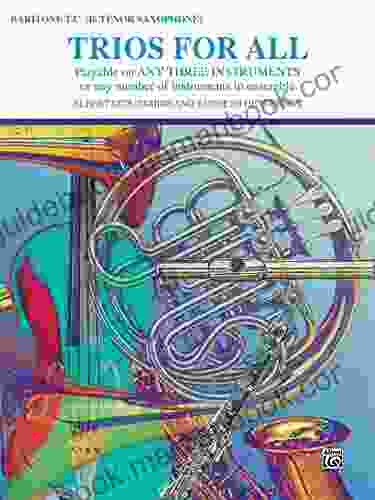Exploring the Tenor Saxophone and Baritone Saxophone: A Comprehensive Guide

The saxophone, a captivating instrument with a distinctive sound, has captivated musicians and audiences for over a century. Among the saxophone family, the tenor saxophone and baritone saxophone stand out as two of the most widely recognized and expressive instruments. In this comprehensive guide, we will delve into the history, construction, playing techniques, and expressive capabilities of these two saxophone giants.
5 out of 5
| Language | : | English |
| File size | : | 7203 KB |
| Screen Reader | : | Supported |
| Print length | : | 24 pages |
| X-Ray for textbooks | : | Enabled |
The History of the Tenor and Baritone Saxophones
The saxophone was invented in 1846 by Adolphe Sax, a Belgian instrument maker. Sax envisioned an instrument that combined the power and projection of brass instruments with the agility and expressiveness of woodwinds. The tenor saxophone, pitched in the key of B♭, was developed in the 1860s, while the baritone saxophone, pitched in the key of E♭, followed in the 1890s.
These instruments quickly gained popularity in both classical and jazz music. In the early 20th century, the tenor saxophone became a staple of big bands, while the baritone saxophone found its place in military bands and classical ensembles.
Construction and Design
Tenor Saxophone
The tenor saxophone is a member of the woodwind family, despite being made of brass. It consists of a curved, conical body with a flared bell. The keys are arranged in a similar manner to those of a clarinet, with the right-hand keys controlling the upper register and the left-hand keys controlling the lower register.
The tenor saxophone has a distinctive, warm, and slightly edgy sound. It is often used for lead melodies, solos, and improvisations.
Baritone Saxophone
The baritone saxophone is the largest and lowest-pitched member of the saxophone family. It is also constructed of brass, with a curved, conical body and a flared bell. The keys are arranged similarly to those of a tenor saxophone, but the instrument is significantly longer.
The baritone saxophone has a deep, rich, and resonant sound. It is often used for bass lines, countermelodies, and supporting harmonies.
Playing Techniques
Embouchure
The embouchure, or the way the player forms their lips on the mouthpiece, is crucial for playing the saxophone. The tenor saxophone requires a more open embouchure than the baritone saxophone, while the baritone saxophone requires a more closed embouchure.
Fingerings
The fingerings for the tenor and baritone saxophones are similar, but there are some key differences. The baritone saxophone has a longer reach, so the fingers must be spread wider apart. Additionally, the baritone saxophone has a lower register, so the left-hand keys are used more frequently.
Tonguing
Tonguing is used to articulate notes on the saxophone. The tongue is placed on the tip of the reed and then quickly removed to create a percussive sound. The speed and placement of the tongue can be used to create a variety of effects.
Vibrato
Vibrato is a technique used to add expression to the sound of the saxophone. It is created by slightly oscillating the pitch of the note. Vibrato can be controlled by the diaphragm, the jaw, or the tongue.
Expressive Capabilities
Range
The tenor saxophone has a range of two and a half octaves, from low B♭ to high F#. The baritone saxophone has a range of two octaves, from low A♭ to high E♭.
Tone Color
The tenor saxophone has a warm, slightly edgy sound that is well-suited for both lead melodies and improvisations. The baritone saxophone has a deep, rich, and resonant sound that is perfect for bass lines and supporting harmonies.
Articulation
The tenor and baritone saxophones can be played with a wide variety of articulations, including legato, staccato, and marcato. The articulation is controlled by the tongue, the fingers, and the breath.
Dynamics
The tenor and baritone saxophones have a wide dynamic range, from pianissimo to fortissimo. The dynamics are controlled by the air pressure, the embouchure, and the fingerings.
The tenor saxophone and baritone saxophone are two of the most versatile and expressive instruments in the saxophone family. They have a rich history, a unique construction, and a wide range of playing techniques and expressive capabilities. Whether you are a seasoned musician or just starting out, the tenor and baritone saxophones are sure to captivate you with their beautiful sounds and endless possibilities.
5 out of 5
| Language | : | English |
| File size | : | 7203 KB |
| Screen Reader | : | Supported |
| Print length | : | 24 pages |
| X-Ray for textbooks | : | Enabled |
Do you want to contribute by writing guest posts on this blog?
Please contact us and send us a resume of previous articles that you have written.
 Top Book
Top Book Novel
Novel Fiction
Fiction Nonfiction
Nonfiction Literature
Literature Paperback
Paperback Hardcover
Hardcover E-book
E-book Audiobook
Audiobook Bestseller
Bestseller Classic
Classic Mystery
Mystery Thriller
Thriller Romance
Romance Fantasy
Fantasy Science Fiction
Science Fiction Biography
Biography Memoir
Memoir Autobiography
Autobiography Poetry
Poetry Drama
Drama Historical Fiction
Historical Fiction Self-help
Self-help Young Adult
Young Adult Childrens Books
Childrens Books Graphic Novel
Graphic Novel Anthology
Anthology Series
Series Encyclopedia
Encyclopedia Reference
Reference Guidebook
Guidebook Textbook
Textbook Workbook
Workbook Journal
Journal Diary
Diary Manuscript
Manuscript Folio
Folio Pulp Fiction
Pulp Fiction Short Stories
Short Stories Fairy Tales
Fairy Tales Fables
Fables Mythology
Mythology Philosophy
Philosophy Religion
Religion Spirituality
Spirituality Essays
Essays Critique
Critique Commentary
Commentary Glossary
Glossary Bibliography
Bibliography Index
Index Table of Contents
Table of Contents Preface
Preface Introduction
Introduction Foreword
Foreword Afterword
Afterword Appendices
Appendices Annotations
Annotations Footnotes
Footnotes Epilogue
Epilogue Prologue
Prologue Joanne Demaio
Joanne Demaio Hermann Bauer
Hermann Bauer Janice Woods Windle
Janice Woods Windle Kellie Coates Gilbert
Kellie Coates Gilbert Gayle Trent
Gayle Trent Erwan Rambourg
Erwan Rambourg Michael Burger
Michael Burger Lauren Blakely
Lauren Blakely Clayton M Christensen
Clayton M Christensen Jason C Gallagher
Jason C Gallagher Shion Miura
Shion Miura William W Johnstone
William W Johnstone Praise Daniels
Praise Daniels Amanda Warwick
Amanda Warwick Ruskin Bond
Ruskin Bond Dolly Alderton
Dolly Alderton Marga Ruth Mead
Marga Ruth Mead Steven Hayden
Steven Hayden Mark O Rowe
Mark O Rowe Suzanne Collins
Suzanne Collins
Light bulbAdvertise smarter! Our strategic ad space ensures maximum exposure. Reserve your spot today!
 Fernando PessoaFollow ·7.8k
Fernando PessoaFollow ·7.8k Charlie ScottFollow ·10.7k
Charlie ScottFollow ·10.7k Brian WestFollow ·6.6k
Brian WestFollow ·6.6k Natsume SōsekiFollow ·16.3k
Natsume SōsekiFollow ·16.3k Shawn ReedFollow ·9.1k
Shawn ReedFollow ·9.1k Andrew BellFollow ·15.8k
Andrew BellFollow ·15.8k Billy FosterFollow ·9.9k
Billy FosterFollow ·9.9k Edward BellFollow ·10.4k
Edward BellFollow ·10.4k

 Leslie Carter
Leslie CarterWhat We Must Do Now To Save Reproductive Freedom
Roe v. Wade, the landmark...

 Cade Simmons
Cade SimmonsThe Unbreakable Bond: Unveiling the Connection Between...
In the realm of...

 Roy Bell
Roy BellFull Contact Chapter Five: The Final Chapter of the Hatch...
In this gripping to the Hatch saga, we...

 Fred Foster
Fred FosterUnveiling the Tale of the Genpei Wars: A Comprehensive...
Deep within the annals of Japanese history,...

 Jaden Cox
Jaden CoxFerguson in Black and White: A Profound Examination of...
The Ferguson tragedy, sparked by the fatal...
5 out of 5
| Language | : | English |
| File size | : | 7203 KB |
| Screen Reader | : | Supported |
| Print length | : | 24 pages |
| X-Ray for textbooks | : | Enabled |














